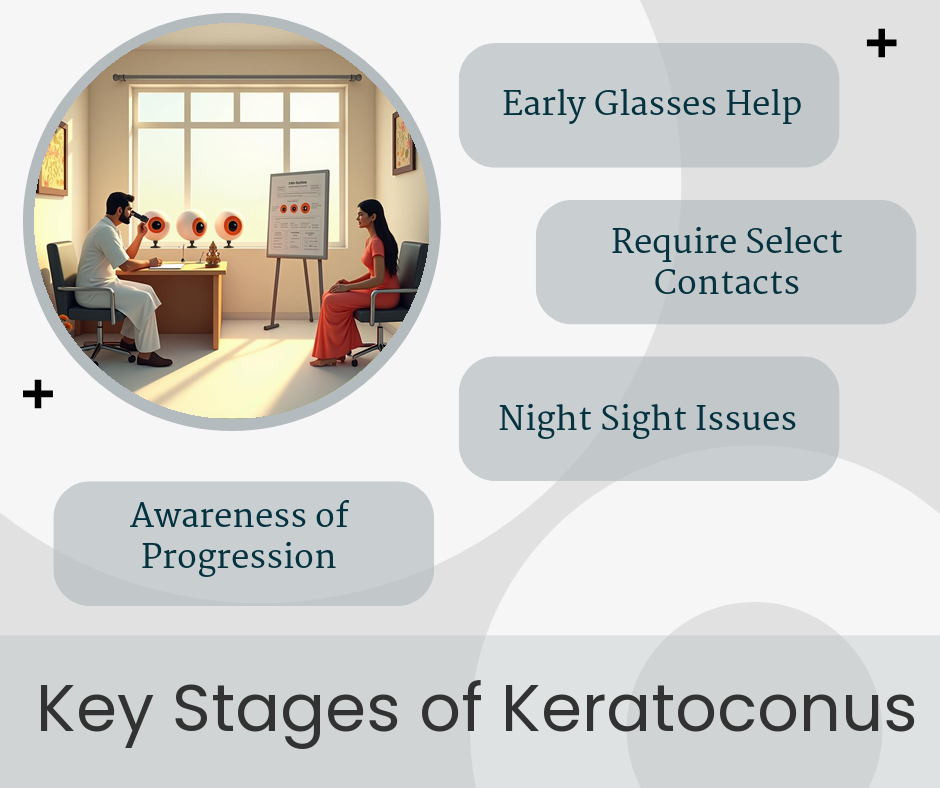Keratoconus is an eye condition that changes how the clear, round front part of your eye bends light. When you have keratoconus, this part, called the cornea, gets thin and starts to bulge out, causing your vision to be unclear. It’s important for everyone to know about this condition so that people can catch it early and manage it better.
Understanding Keratoconus and Its Symptoms
Keratoconus makes the cornea, the front part of the eye, thin and shape like a cone, which results in your vision becoming blurry. It’s crucial to spot symptoms like blurry sight, being sensitive to light, or needing new glasses often to identify the condition early. Knowing what causes keratoconus and the factors involved is key to handling and treating it well.
Symptoms usually start in teenage years and might include:
- Blurry vision
- Lights causing discomfort or glare
- The eyes seeing double images
- Needing new glasses often
As the condition advances, these symptoms can become more pronounced. Recognizing them lets patients and caregivers distinguish between mild and severe stages, ensuring timely intervention.
Stages and Impact of Keratoconus on Vision
Keratoconus gradually gets worse. It starts where eyeglasses for keratoconus or soft lenses can help. At an advanced stage, special contacts for keratoconus are needed. These contacts can be keratoconus lenses specifically designed to help with vision problems.
As the condition progresses, it can make daily tasks really tough. Things like driving at night or reading smaller prints become harder because of light sensitivity or halos around lights. People with this condition also have a hard time seeing clearly at night or in dim light. Knowing these progression stages helps you get the right help when you need it.
Exploration of Treatment Options for Keratoconus
In the early stages, eyeglasses for keratoconus or soft contacts for keratoconus might be enough. But as the condition advances, you might need hard contact lenses for keratoconus or even surgery.
Some types of lenses that can help include: – Rose k contact lenses – Kerasoft contact lens – Hybrid contact lenses for keratoconus
These options bring improvements and can slow how keratoconus gets worse. By learning about all these choices, patients feel empowered. They gain confidence to talk about what treatment feels right for them.
Impact on Daily Life and Managing Keratoconus
Living with keratoconus can be challenging every day. Your eyes might feel strained, and you could feel a bit down emotionally with cloudy vision. But making small lifestyle changes can help you manage better and minimize discomfort.
To ease symptoms: – Get special contact lenses for keratoconus – Use eyeshades or avoid bright lights – Keep up with eye check-ups routinely
Supplies like gas permeable contact lenses for keratoconus can minimize stress on your eyes too. Support groups and mental resources may also be beneficial for anyone dealing with this eye condition.
Conclusion: The Importance of Awareness and Early Detection
Keratoconus is an eye condition that requires careful attention. Recognizing it early on can improve management and even slow its advancement. Encouraging people to visit eye doctors or optometrists promptly when unsure of symptoms is essential for keeping vision optimal.
Understanding keratoconus not only aids in personal management but also fosters community advocacy for eye care awareness. Raising awareness removes any misinformation and encourages a more active approach to protecting eye health. Informed communities can look after their vision better, promoting a holistic approach to health and well-being.


